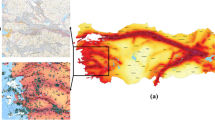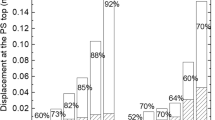Abstract
The seismic performance of a fully fabricated bridge is a key factor limiting its application. In this study, a fiber element model of a fabricated concrete pier with grouting sleeve-prestressed tendon composite connections was built and verified. A numerical analysis of three types of continuous girder bridges was conducted with different piers: a cast-in-place reinforced concrete pier, a grouting sleeve-fabricated pier, and a grouting sleeve-prestressed tendon composite fabricated pier. Furthermore, the seismic performance of the composite fabricated pier was investigated. The results show that the OpenSees fiber element model can successfully simulate the hysteresis behavior and failure mode of the grouted sleeve-fabricated pier. Under traditional non-near-fault ground motions, the pier top displacements of the grouting sleeve-fabricated pier and the composite fabricated pier were less than those of the cast-in-place reinforced concrete pier. The composite fabricated pier had a good self-centering capability. In addition, the plastic hinge zones of the grouting sleeve-fabricated pier and the composite fabricated pier shifted to the joint seam and upper edge of the grouting sleeve, respectively. The composite fabricated pier with optimal design parameters has good seismic performance and can be applied in high-intensity seismic areas; however, the influence of pile-soil interaction on its seismic performance should not be ignored.
Similar content being viewed by others
References
Ameli M J, Parks J E, Brown D N, Pantelides C P. Seismic evaluation of grouted splice sleeve connections for reinforced precast concrete column-to-cap beam joints in accelerated bridge construction. PCI Journal, 2015, 60(2): 80–103
Kurama Y C, Sritharan S, Fleischman R B, Restrepo J I, Henry R S, Cleland N M, Ghosh S K, Bonelli P. Seismic-resistant precast concrete structures: State of the art. Journal of Structural Engineering, 2018, 144(4): 03118001
Al-Rousan R. Behavior of prefabricated full-depth precast concrete bridge deck panel system: Optimum prestress level. Procedia Manufacturing, 2020, 44: 607–614
Qu H Y, Li T T, Wang Z Q, Wei H, Shen J, Wang H. Investigation and verification on seismic behavior of precast concrete frame piers used in real bridge structures: Experimental and numerical study. Engineering Structures, 2018, 154: 1–9
Li T T, Qu H Y, Wang Z Q, Wei H, Jiang S. Seismic performance of precast concrete bridge columns with quasi-static cyclic shear test for high seismic zones. Engineering Structures, 2018, 166: 441–453
Wang Z Q, Zhang Y B, Jiang S C, Wei H, Yan X. Experimental study of shear performance of precast segmental bridge piers with grouted splice sleeve. Journal of Tongji University (Natural Science), 2018, 46(6): 767–775
Xin G T, Xu W B, Wang J, Yan X, Chen Y, Yan W, Li J. Seismic performance of fabricated concrete piers with grouted sleeve joints and bearing-capacity estimation method. Structures, 2021, 33: 169–186
Haber Z B, Mackie K R, Al-Jelawy H M. Testing and analysis of precast columns with grouted sleeve connections and shifted plastic hinging. Journal of Bridge Engineering, 2017, 22(10): 04017078
Al-Jelawy H M, Mackie K R, Haber Z B. Shifted plastic hinging for GS column connections. ACI Structural Journal, 2018, 115(4): 1101–1114
Nishiyama M, Wei Y. Effect of post-tensioning steel Anchorage location on seismic performance of exterior beam-to-column joints for precast, prestressed concrete members. PCI Journal, 2007, 52(2): 18–30
Li C, Hao H, Zhang X H, Bi K. Experimental study of precast segmental columns with unbonded tendons under cyclic loading. Advances in Structural Engineering, 2018, 21(3): 319–334
Wang S J, Xu W B, Wang J, Xin G, Chen Y, Zhao Z, Bai Y. Experimental research on anti-seismic reinforcement of fabricated concrete pier connected by grouting sleeve based on CFRP and PET materials. Engineering Structures, 2021, 245: 112838
Ou Y C, Chiewanichakorn M, Aref A J, Lee G C. Seismic performance of segmental precast unbonded posttensioned concrete bridge columns. Journal of Structural Engineering, 2007, 133(11): 1636–1647
Palermo A, Pampanin S, Marriott D. Design, modeling, and experimental response of seismic resistant bridge piers with posttensioned dissipating connections. Journal of Structural Engineering, 2007, 133(11): 1648–1661
Hewes J T. Seismic design and performance of precast concrete segmental bridge columns. Dissertation for the Doctoral Degree. San Diego: University of California, 2002
Chou C C, Chang H J, Hewes J T. Two-plastic-hinge and two dimensional finite element models for post-tensioned precast concrete segmental bridge columns. Engineering Structures, 2013, 46 (Jan): 205–217
Han W L, Zhao Z Z, Qian J R, Cui Y, Liu S. Seismic behavior of precast columns with large-spacing and high-strength longitudinal rebars spliced by epoxy mortar-filled threaded couplers. Engineering Structures, 2018, 176: 349–360
Yang C C, Okumus P, Ren R L. A hysteretic model for self-centering precast concrete piers with varying shear-slip between segments. Engineering Structures, 2019, 188: 350–361
Liu H T, Chen J N, Xu C S, Du X. Seismic performance of precast column connected with grouted sleeve connectors. Journal of Building Engineering, 2020, 31: 101410
Abdelkarim O I, Gheni A A, Anumolu S, Elgawady M A. Hollow-core FRP-concrete-steel tubular columns subjected to seismic loading. In: Symposium on Towards Sustainable Infrastructure with Fiber Reinforced Polymer Composites. Kansas: American Concrete Institute, 2014, 185–200
Elgawady M A, Dawood H M. Analysis of segmental piers consisted of concrete filled FRP tubes. Engineering Structures, 2012, 38: 142–152
Dawood H, Elgawady M, Hewes J. Behavior of segmental precast posttensioned bridge piers under lateral loads. Journal of Bridge Engineering, 2012, 17(5): 735–746
Zhang Q, Alam M S. Evaluating the seismic behavior of segmental unbounded posttensioned concrete bridge piers using factorial analysis. Journal of Bridge Engineering, 2016, 21(4): 04015073
Wang Z Q, Ge J P, Wei H Y. Seismic performance of precast hollow bridge piers with different construction details. Frontiers of Structural and Civil Engineering, 2014, 8(4): 399–413
Ou Y C. Precast segmental post-tensioned concrete bridge columns for seismic regions. Dissertation for the Doctoral Degree. Buffalo: State University of New York at Buffalo, 2007
Tazarv M, Saiidi M S. UHPC-filled duct connections for accelerated bridge construction of RC columns in high seismic zones. Engineering Structures, 2015, 99 (sep.15): 413–422
Zhuo W D, Tong T, Liu Z. Analytical pushover method and hysteretic modeling of precast segmental bridge piers with high-strength bars based on cyclic loading test. Journal of Structural Engineering, 2019, 145(7): 04019050
Ge J P. Seismic performance analysis of a continuous girder bridge with precast segmental pier. In: 1st International Conference on Civil Engineering, Architecture and Building Materials (CEABM 2011). Clausthal-Zellerfeld: Trans Tech Publications, 2011, 1966–1970
Zhao L F, Bi K M, Hao H, Li X. Numerical studies on the seismic responses of bridge structures with precast segmental columns. Engineering Structures, 2017, 151: 568–583
Royero J B, Saiidi M S, Itani A. Seismic performance analysis and assessment of a precast bridge computational model. Dyna (Medellín, Colombia), 2020, 87(212): 80–89
Liu H T, Wang Z Y, Xu C S, Du X. Influence of axial compression ratio on the seismic performance of precast columns with grouted sleeve connections. Journal of Structural Engineering, 2021, 147(12): 04021194
Jia J, Zhang K, Saiidi M S, Guo Y, Wu S, Bi K, Du X. Seismic evaluation of precast bridge columns with built-in elastomeric pads. Soil Dynamics and Earthquake Engineering, 2020, 128: 105868
Bu Z Y, Ou Y C, Song J W, Zhang N S, Lee G C. Cyclic loading test of unbonded and bonded posttensioned precast segmental bridge columns with circular section. Journal of Bridge Engineering, 2016, 21(2): 04015043
Wang X L, Ye L P, Lu X Z. Numerical simulation for the hysteresis behavior of prestressed concrete structures under cyclic loads. Earthquake Resistant Engineering and Retrofitting, 2006, 6: 28–32 (in Chinese)
Song L L, Guo T, Chen C. Experimental and numerical study of a self-centering prestressed concrete moment resisting frame connection with bolted web friction devices. Earthquake Engineering & Structural Dynamics, 2014, 43(4): 529–545
Hua L J, Rahman A B A, Ibrahim I S. Feasibility study of grouted splice connector under tensile load. Construction & Building Materials, 2014, 50: 530–539
Fan J J, Feng D C, Wu G, Hou S, Lu Y. Experimental study of prefabricated RC column-foundation assemblies with two different connection methods and using large-diameter reinforcing bars. Engineering Structures, 2020, 205: 110071–110075
Liu H T, Han Q, Bai Y L, Xu C, Du X. Connection performance of restrained deformed grouted sleeve splice. Advances in Structural Engineering, 2018, 21(3): 488–499
Zhao J, Sritharan S. Modeling of strain penetration effects in fiber-based analysis of reinforced concrete structures. ACI Structural Journal, 2007, 104(2): 133–141
FIB Task Group on Bond Models. Bond of Reinforcement in Concrete. Lausanne: International Federation for Structural Concrete (fib), 2000
JG/T 408-2013. Cementitious Grout for Coupler of Rebar Splicing. China: Ministry of Housing and Urban-Rural Development of the People’s Republic of China, 2013 (in Chinese)
Ding Y N, Xu W B, Chen Y J, Wang J, Yan W. Experimental research on seismic performance of precast cogging high-strength bolt composite joint and influence of its arrangement location. Engineering Structures, 2020, 225: 111294
Mohebbi A, Saiidi M S, Itani A M. Shake table studies and analysis of a precast two-column bent with advanced materials and pocket connections. Journal of Bridge Engineering, 2018, 23(7): 04018041–04018046
JTG/T 2231-01-2020. Specifications for Seismic Design of Highway Bridges. China: Ministry of Transport of the People’s Republic of China, 2019 (in Chinese)
JTG 3363-2019. Specifications for Design of Foundation of Highway Bridges and Culverts. China: Ministry of Transport of the People’s Republic of China, 2019 (in Chinese)
Xie W, Sun L M. Assessment and mitigation on near-fault earthquake wave effects on seismic responses and pile-soil interactions of soil-pile-bridge model. Soil Dynamics and Earthquake Engineering, 2021, 143: 106596
Li S, Zhang F, Wang J Q, Alam M S, Zhang J. Seismic responses of super-span cable-stayed bridges induced by ground motions in different sites relative to fault rupture considering soil-structure interaction. Soil Dynamics and Earthquake Engineering, 2017, 101: 295–310
Zheng J Z, Takeda T. Effects of soil-structure interaction on seismic response of PC cable-stayed bridge. Soil Dynamics and Earthquake Engineering, 1995, 14(6): 427–437
Khan R A, Ahmad S, Datta T K. Effect of soil-structure interaction on seismic risk of FAN type cable stayed bridges. Journal of Seismology and Earthquake Engineering, 2004, 6(2): 47–56
Acknowledgements
This study was supported by the National Natural Science Foundation of China (Grant Nos. 52108428, 52178446, 51978021, and 51908015), and the Fundamental Research Funds for the Central Universities (No. 2023MS067). We gratefully acknowledge their support.
Author information
Authors and Affiliations
Corresponding author
Ethics declarations
The authors declare that they have no conflict of interest.
Rights and permissions
About this article
Cite this article
Wang, J., Xu, W., Du, X. et al. Seismic performance of fabricated continuous girder bridge with grouting sleeve-prestressed tendon composite connections. Front. Struct. Civ. Eng. 17, 827–854 (2023). https://doi.org/10.1007/s11709-023-0954-1
Received:
Accepted:
Published:
Issue Date:
DOI: https://doi.org/10.1007/s11709-023-0954-1




